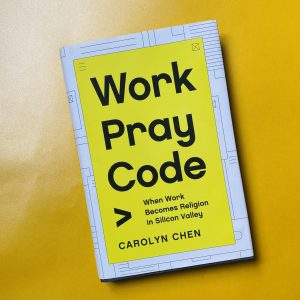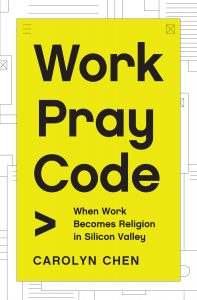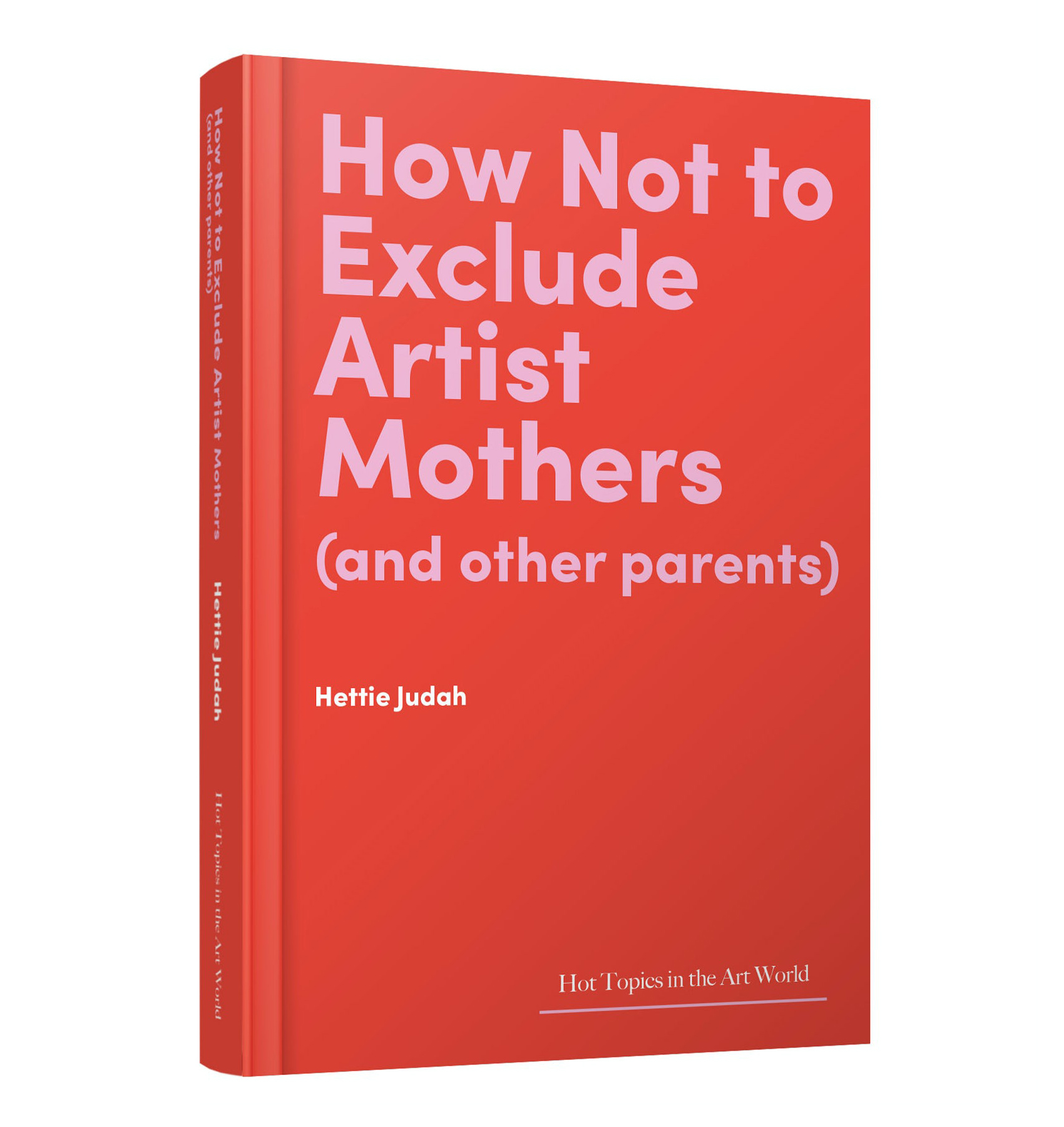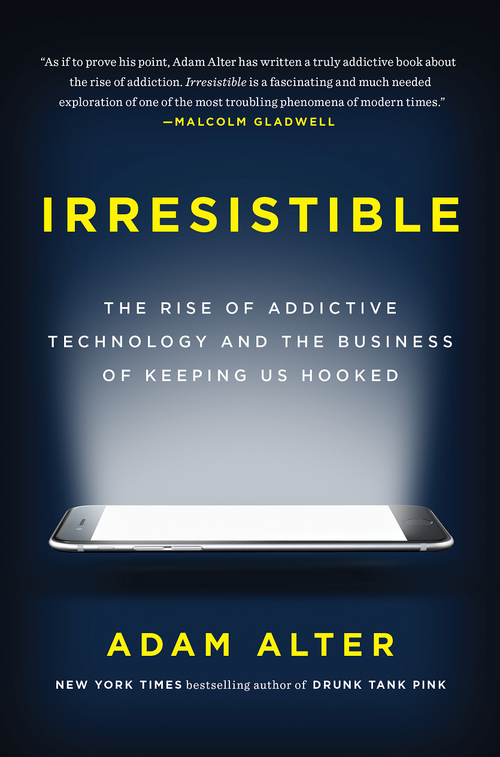"There is no artist mother paradigm. So, when I, as a middle-aged woman, make art, people assume it’s my nice hobby. They don’t take me seriously because it’s not a paradigm that we celebrate or that’s particularly visible, culturally. But being an artist mother is an identity that, once it’s articulated, people feel very strongly."—Hettie Judah, on the artist mother identity.
Capitalizing on Connection A Review of Work Pray Code by Carolyn Chen
 “On paper, Silicon Valley is one of the least religious places in America,” writes Carolyn Chen in her book, Work Pray Code: When Work Becomes Religion in Silicon Valley. However, she argues, tech companies increasingly vie for knowledge workers with on-site meals and services, fitness programs, mindfulness, community, and personal coaching—packages of corporate maternalism that blur and sometimes obliterate the boundary between work and life. Employees bask in the perks and personal growth, spending increasingly more of themselves at work or work-sponsored activities. The company effectively hoards time, energy and enthusiasm that would otherwise go to families, churches, or local communities, producing a workforce that is cut off from the outside, much like a cult.
“On paper, Silicon Valley is one of the least religious places in America,” writes Carolyn Chen in her book, Work Pray Code: When Work Becomes Religion in Silicon Valley. However, she argues, tech companies increasingly vie for knowledge workers with on-site meals and services, fitness programs, mindfulness, community, and personal coaching—packages of corporate maternalism that blur and sometimes obliterate the boundary between work and life. Employees bask in the perks and personal growth, spending increasingly more of themselves at work or work-sponsored activities. The company effectively hoards time, energy and enthusiasm that would otherwise go to families, churches, or local communities, producing a workforce that is cut off from the outside, much like a cult.
Chen puts it plainly: “Work is simultaneously displacing and absorbing religion.”
Work Pray Code is the result of Chen’s five-plus years of research in Silicon Valley, during which she interviewed employees, managers, HR, executive coaches, and the spiritual leaders invited to teach a work-friendly version of religion on the company dime. Chen’s story is therefore often told through the words of people who experience it firsthand. For example, we hear from an executive coach who explains why companies ought to offer care services to their employees, saying that it “makes economic sense to treat people as a whole person because there is a big difference between compliance and commitment. If you treat someone as a thing, you may get them to comply, but you can’t put a price on what someone will do if they are committed.” An executive likewise expresses the benefit of mining the “spiritual need for connection to self, others, and universe” for productive labor. Some employees describe the feeling of meaning they get from their work, and how they expect their apps will “change the world” or “[help] humanity thrive.” Most speak in the language of transcendence, albeit stripped of the divine. The fascinating part of reading the various parties speak in their own words is that, depending on your stance, their portrayals can easily represent either a utopia or a dystopia.

The dysfunction of a working relationship in which employers take responsibility for the “whole person” while employees happily bring their “authentic selves” to work is not necessarily self-evident. That is, it could be argued as a mutualistic relationship in which all benefit or, in business parlance, a win-win. Chen’s analysis is not itself scathing, but seeks to assess what is gained and lost by this newfound corporate maternalism. After all, she points out, it was once the case that religion was “a sanctuary from, and even a prophetic critic of, the crushing instrumentalism of work,” so it bears asking what happens when work and religion are conjoined.
The instrumentalism of work is a key factor here when trying to discern consequences. The spirituality introduced by workplaces is “a means to an end, not an end in itself.” This means that when workers learn meditation from company-sponsored gurus, or work with coaches on their limiting beliefs, it’s not a spiritual practice but a productivity practice. The outcome must be measurable. The change must be quantifiable not just by the individual but with some demonstrable effect to the company’s bottom line. Yet Chen rightly points out that transformative experiences cannot be compartmentalized to booked timeslots in a company meeting room.

Work Pray Code explains how religion is able to be brought into the workplace at all—not wholesale but rather stripped down to an office-safe palatability. After all, Silicon Valley holds an open and pervasive antagonism toward organized religion and the “airy fairy” or “woo-woo” qualities of spirituality. Rather, the language is codified in agnostic self-improvement buzzwords, such as “unleash your potential,” “be your best self,” “bring your whole self to work,” and “authenticity in the workplace.” Most of the developmental tools that are introduced, such as meditation, are Buddhist practices decoupled from their religious roots and reframed as “self-hacking” or “optimization.” This reduces a complex belief system to its superficial benefits, replacing inherent spiritual growth with instrumental gains to a marketable skillset, and leaving an individual’s inner world vulnerable to be harvested for capitalistic gain. Moreover, by framing work as an inherent good, it enlists the individual into participating in their own harvest, leading to burnout and alienation from other restorative relationships. If the gig economy celebrates working yourself to death, then Silicon Valley dogmatizes it.
There is also a deep cost to communities and societies who host these tech companies, as Chen points out. When so many services (like healthy meals and campus transport) are provided as an employment perk, it drains the area of local businesses and services that are available to the public; quality of life becomes privatized. Additionally, because these perks are offered exclusively to knowledge workers, those who provide support services like janitors and food-service workers are left out of the company’s machinery of self-improvement. This not only creates a technocratic elite, Chen argues, it corrodes “the collective capacity to build and sustain a common good.”
What we see in the workplace version of Buddhism is also a disturbing manifestation of what Alain de Botton proposed in his TED talk, Atheism 2.0: stealing from religion. “If you don’t believe in a religion,” he says, “there’s nothing wrong with picking and mixing, with taking out the best sides of religion.” He’s of course correct in saying that the secular world is full of holes, and may have thrown the baby out with the bathwater by discarding religion in its entirety. De Botton’s proposal was to imbue the significance of religion into art, rather than work, which has considerable more alignment in purpose since art ideally doesn’t have an instrumental end. However, in Silicon Valley, we can see what happens when religious practices and the search for meaning are shucked of their spiritual underpinnings.
Yet, regardless of the object of a religion, whether spiritual or secular, the worship of an idol is bound to disappoint eventually. Those in the throes of work-as-religion are vulnerable to the same crushing reckoning as the religious when god fails them: a crisis of faith. (See for example, Emi Nietfeld’s New York Times article: “After Working at Google, I’ll Never Let Myself Love a Job Again.”)

Chen’s focus in this book is Silicon Valley, though the phenomenon that she describes is now a widely recognizable trend of urban tech companies worldwide. In this sense, Work Pray Code isn’t exactly surprising because it’s all happening in broad daylight, but what Chen manages to do is lay out in excruciating detail how and why this has all come to be. Silicon Valley is a deeply concentrated tech workforce, and many of the now common corporate maternalistic perks originated from the competitive tech ecosystem of Google et al. The policies there feed work instructions to tech companies around the world who aim to be “Google-like.” Chen’s analysis therefore provides a crucial warning to would-be copycat companies as well as the parishioners of startup evangelism: Be careful what you worship.
 Work Pray Code: When Work Becomes Religion in Silicon Valley is available from Princeton University Press.
Work Pray Code: When Work Becomes Religion in Silicon Valley is available from Princeton University Press.



